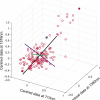Tony Davies Columns
A.M.C. Daviesa and Tom Fearnb
aNorwich Near Infrared Consultancy, 75 Intwood Road, Cringleford, Norwich NR4 6AA, UK
bDepartment of Statistical Science, University College London, Gower Street, London, UK
Tony N. Davies,a Robert J. Lancasterb and Peter Lampenc
aExternal Professor, University of Glamorgan, UK
c/o Waters Informatics, Europaallee 27–29, 50226 Frechen, Germany
bUniversity of West Indies, Mona Campus, Jamaica
cISAS, Institute for Analytical Science, Bunsen-Kirchoff-Strasse 11, 44139 Dortmund, Germany
A.M.C. Daviesa and Tom Fearnb
aNorwich Near Infrared Consultancy, 75 Intwood Road, Cringleford, Norwich NR4 6AA, UK
bDepartment of Statistical Science, University College London, Gower Street, London, UK
Tony Davies
External Professor, University of Glamorgan, UK
c/o Waters Informatics, Europaallee 27–29, 50226 Frechen, Germany
A.M.C. Davies
Norwich Near Infrared Consultancy, 75 Intwood Road, Cringleford, Norwich NR4 6AA, UK
Introduction
In my last column I began a revision of basic chemometrics.1 In this column I will discuss some interpretation of the results produced by principal component analysis (PCA) as part two of this revision programme.
Tony Davies
External Professor, University of Glamorgan, UK, c/o Waters Informatics, Europaallee 27–29, 50226 Frechen, Germany
PCA is a mathematical method of reorganising information in a data set of samples. It can be used when the set contains information from only a few variables but it becomes more useful when there are large numbers of variables, as in spectroscopic data.
Peter Lampena and Tony Daviesb
aISAS, Institute for Analytical Sciences, Bunsen-Kirchhoff-Str.11, 44139 Dortmund, Germany
bExternal Professor, University of Glamorgan, UK. c/o Waters Informatics, Europaallee 27–29, 50226 Frechen, Germany
A.M.C. Davies
Norwich Near Infrared Consultancy, 75 Intwood Road, Cringleford, Norwich NR4 6AA, UK
Tony Davies
External Professor, University of Glamorgan, UK c/o Waters Informatics, Europaallee 27–29, 50226 Frechen, Germany
A.M.C. Davies
Norwich Near Infrared Consultancy, 75 Intwood Road, Cringleford, Norwich NR4 6AA, UK
Tony Davies
External Professor, University of Glamorgan, UK, c/o Creon Lab Control AG, Europaallee 27–29 50226 Frechen, Germany
A.M.C. Davies
Norwich Near Infrared Consultancy, 75 Intwood Road, Cringleford, Norwich NR4 6AA, UK
Tony Davies,a Peter Lampen,b Maren Fiege,c Thorsten Richterc and Thorsten Fröhlichc
aExternal Professor, University of Glamorgan, UK. c/o Creon Lab Control AG, Europaallee 27-29 50226 Frechen, Germany
bISAS, institute for Spectrochemistry and Applied Spectroscopy, Dortmund, Germany
cCreon Lab Control AG, Europaallee 27-29 50226 Frechen, Germany
The International Spectroscopic Database (IS-DB) went live on 19 May 2003. Following over seven years fighting for funding and receiving the EU EuroSpec grant1 in 2002 the team are pleased to announce that the first version of the international digital archive for spectroscopic data was switched on for data deposition in May.
Tony Davies
External Professor, University of Glamorgan, UK c/o Creon Lab Control AG, Europaallee 27–29, 50226 Frechen, Germany
A.M.C.Davies,a and Tom Fearn,b
aNorwich Near Infrared Consultancy, 75 Intwood Road, Cringleford, Norwich NR4 6AA,UK
bDepartment of Statistical Science, University College London, Gower Street, London
D.B. Coates
CSIRO Sustainable Ecosystems, Davies Laboratory, PMB PO Aitkenvale, Qld 4814, Australia
Tony Davies
External Professor, University of Glamorgan, UK. c/o Creon Lab Control AG, Europaallee 27-29, 50226 Frechen, Germany
Tony M.C. Davies
Norwich Near Infrared Consultancy, 75 Intwood Road, Cringleford, Norwich NR4 6AA,UK
Tom Fearn
Department of Statistical Science, University College London, Gower Street, London



 The Tony Davies Column covers a wide range of topics of interest to spectroscopists in both industry and academe, with an emphasis on data handling and processing. Read more about the
The Tony Davies Column covers a wide range of topics of interest to spectroscopists in both industry and academe, with an emphasis on data handling and processing. Read more about the